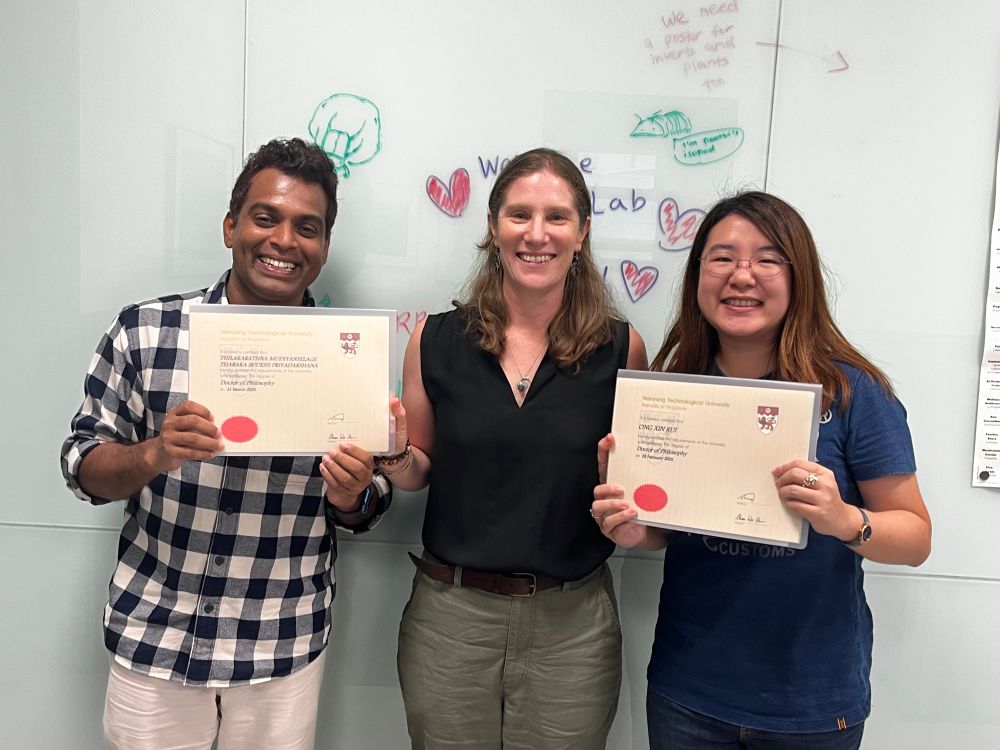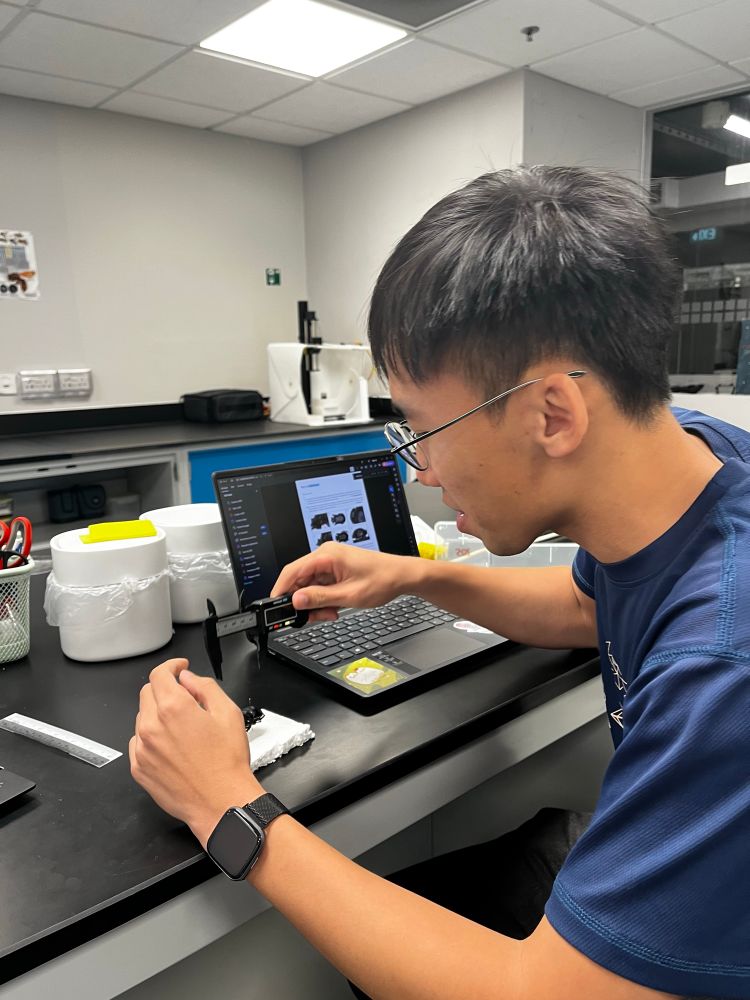

Huge congratulations to Dr. @xinruiong.bsky.social & Dr. @tharakasp.bsky.social on receiving their graduation scrolls and transcripts! A proud moment for their supervisor @eleslade.bsky.social #TEELab
16.04.2025 12:37 — 👍 9 🔁 5 💬 0 📌 0
congrats Tharaka!!! 😋😋🎉🎉🎉
13.02.2025 14:35 — 👍 1 🔁 0 💬 0 📌 0


🔬 Our undergrad student under supervision of @eleslade.bsky.social is looking at the effects of the #AfricanSwineFlu outbreak on dung beetle populations in Sabah, Borneo, while measuring key traits. Stay tuned for some cool results! 🪲✨ #TEELab
04.02.2025 06:37 — 👍 10 🔁 5 💬 0 📌 0
 23.01.2025 17:20 — 👍 18285 🔁 666 💬 306 📌 25
23.01.2025 17:20 — 👍 18285 🔁 666 💬 306 📌 25

Graphical abstract showing the identified knowledge and capacity gaps in insect occurrence records, insect studies and #conservation posts. Proposed solutions to address these gaps are listed: Promote better coverage of all insect groups, increase public engagement and local monitoring, apply integrative taxonomy approaches, encourage regional collaboration and increase funding and political recognition.
Ushering in 2025 is our latest publication in Ecology Letters! Through a quantitative assessment of insect occurrence records, insect studies and '#conservation' posts, we identified gaps in five areas and suggest potential solutions to enable insect conservation efforts in Southeast Asia. (1/n)
01.01.2025 12:41 — 👍 36 🔁 12 💬 2 📌 4

An adult female oak treehopper rests on branch facing many small brown treehopper nymphs.

An adult female oak treehopper rests on branch facing a single small treehopper nymph.

An adult female oak treehopper rests on branch facing a single black, white, and red treehopper nymph about half her size.

An adult female oak treehopper rests on branch face-to-face with a large black, white, and red nymph nearly her length.
Oak treehoppers have my whole heart. These photos show the difference in size between mamas and their offspring at varying instars. I love them so much. 💛 Mamas stay with their babies throughout their development, protecting them from predators like wasps. Unusual behavior for a bug.
16.01.2025 21:51 — 👍 1654 🔁 203 💬 38 📌 13

A spiral galaxy with a wide, oval-shaped disc. It has a shining spot at the centre from which two curving, pale red spiral arms emerge, wrapping once each around the galaxy. They’re surrounded by a whirl of bright threads and patches of dust, with spots of star formation scattered throughout. The glow of the disc fades smoothly into the background where some patches of dust can be seen, as well as foreground stars.

Image of a galaxy on the black background of space. The galaxy is a very oblong, blue disk that extends from left to right at an angle (from about 10 o’clock to 5 o’clock). The galaxy has a small bright core at the center. There is an inner disk that is clearer, with speckles of stars scattered throughout. The outer disk of the galaxy is whiteish-blue, and clumpy, like clouds in the sky. There are different colored dots, distant galaxies, speckled among the black background of space surrounding the galaxy.

Two spiral galaxies take the shape of a colorful beaded mask that sits above the nose. The galaxy at left, IC 2163, is smaller, taking up a little over a quarter of the view. The galaxy at right, NGC 2207, takes up half the view, with its spiral arms reaching the edges. IC 2163 has a bright orange core, with two prominent spiral arms that rotate counter clockwise and become straighter towards the ends, the left side extending almost to the edge. Its arms are a mix of pink, white, and blue, with an area that takes the shape of an eyelid appearing whitest. NGC 2207 has a very bright core. Overall, it appears to have larger, thicker spiral arms that spin counter clockwise. This galaxy also contains more and larger blue areas of star formation that poke out like holes from the pink spiral arms. In the middle, the galaxies’ arms appear to overlap. The edges show the black of space, including extremely distant galaxies that look like orange and red smudges, and a few foreground stars.

A large spiral galaxy takes up the entirety of the image. The core is mostly bright white, but there are also swirling, detailed structures that resemble water circling a drain. There is small white and pale blue light that emanates from stars and dust at the core’s center, but it is tightly limited to the core. The rings feature colors of deep red and orange and highlight filaments of dust around cavernous black bubbles.
jwst’s recent images 🌌
08.12.2024 01:30 — 👍 7856 🔁 770 💬 61 📌 35

found a colugo (Galeopterus variegatus) at the end of our fieldwork! 🤩
being able to see Singapore’s wildlife is definitely one of my favourite parts about being an ecologist!
05.12.2024 08:49 — 👍 8 🔁 0 💬 0 📌 0

The taxonomic biases in biodiversity data are growing over time. The amount of data we are collecting is growing, but the biases get bigger. We need to make a conscious effort to study the understudied!
#SciComms #Science #Taxonomy
🧪 image from Troudet et al 2018
@natureportfolio.bsky.social
19.11.2024 09:54 — 👍 223 🔁 103 💬 13 📌 21


This is our lab account and we focus on how species respond to environmental change and the consequences this has for species interactions and ecosystem functioning. We have a soft spot for invertebrates, but we have also been known to work on birds, mammals, plants & microbes! #teelab
17.11.2024 10:36 — 👍 10 🔁 5 💬 0 📌 1
hehe love you 🫶🏻
22.11.2024 11:27 — 👍 1 🔁 0 💬 0 📌 0
Science integrity consultant and crowdfunded volunteer, PhD.
Ex-Stanford University. Maddox Prize/Einstein F Award winner
NL/USA/SFO.
#ImageForensics
@MicrobiomDigest on X.
Blog: ScienceIntegrityDigest.com
Support me: https://www.patreon.com/elisabethbik
Amateur wildlife photographer & invert keeper (millipedes, but also some beetles, tarantula, isopods, and Gryllus crickets)
Interested in most invertebrate orders, but especially Diplopoda, Isopoda, and Hymenoptera.
My OC photography is CC0 public domain
Postdoc | @David Berger @Uppsala University | Ecologist | #climate_change #fertility #adaptation | BS-MS @IISERMohali @NG Prasad | PhD @UZH_ch @Stefan Lupold | 🇮🇳➡️🇨🇭➡️🇸🇪
• Insect & Arachnid Nerd 🕷️• Polyamorous Sapphic 🏳️🌈 • Support Libraries & Read Queer Books! 📚 • Woman in STEM (Plant Biology)🌿 • Waterfall-Chasing PNW Girl • 100000% Total Goofball.
We explore how evolution, ecology and biological clocks interact,
with a focus on lunar rhythms in development and reproduction
of the marine insect Clunio.
+ Genomics | Biodiversity | Behaviour | NeuroBio | MolBio | SciCom
bit.ly/KaiserLab
Evolutionary Biologist & Scientific Naturalist | Associate Professor | Director, E4 Initiative | @RiceUniversity #science #biology #evolution #speciation #entomology #biodiversity #genomics #discovery
Lab website: https://scottpegan.com
🌱 #History, #Botany, #Plants, #Gardening, #Art, #Allotment, Economic & Social History, Small-scale food production, Cricket. Mending old things and restoring old houses. Location 🇬🇧
I reply to comments on my posts, but not often to DMs
Studying why and how behavior evolves, from mosquitoes to mole-rats | Postdoc/Leon Levy Scholar @Columbia working with Ishmail Abdus-Saboor | PhD @Princeton with Lindy McBride | 麻布/東大 alum 🇯🇵 | yukihaba.github.io
Assistant Director (BAO) | Research Assistant - Laboratory of Applied Entomology and Acarology | Writer
PhD Researcher @newcastleuni.bsky.social @ForagingEcology.bsky.social investigating impacts of artifical light at night on ecological networks, using eDNA and nutritional analysis 🧬🔬🌿🐛🐜🪲🦗🦋🪳🐝🐞🕷
Itching to understand why mosquitos always find and bite me 🦟 | Assistant Professor @fiu.bsky.social 🐆 | PhD @berkeleymcb.bsky.social🧸 | Postdoc @rockefelleruniv.bsky.social🗽 | https://www.moritalaboratory.org
The open-access, peer-reviewed journal of the Orthopterists' Society. Publishes research on Orthoptera and allies. Published by Pensoft.
Website: jor.pensoft.net
Entomologist 🐜🦋🐞🐛🐝
Postdoc investigating interactions between cover crops 🌾🌸🌺🪻, ants 🐜, pests 🐛, natural enemies 🕷️🐞 and the effect on biological control.
CT microscopist at UIUC's Beckman Institute (@beckmanillinois.bsky.social) 🔬
Entomologist and biomechanist by training 🐜 Sometimes tweet about Pokemon. Furret Aficionado. Opinions my own.
Science journalist covering all fields. Formerly an editor at New Scientist and Nature. Particular fan of health, mushrooms, amphibians, marine life and nature 🧪🐸 🍄
Selection of articles here: https://www.newscientist.com/author/chris-simms/
Okinawa Institute of Science and Technology: https://www.oist.jp
沖縄科学技術大学院大学: https://www.oist.jp/ja
Assistant Professor @oistedu.bsky.social. Microbial Ecologist, Ecosystem Ecologist, and Mom of two🦠🍄🌏🌳🍃👩🔬
https://www.oist.jp/research/research-units/mee/chikae-tatsumi
Bug, microbiome, and -omics enthusiast. UTSC Postdoc studying wood-eating wasps and moths. Aspiring academic twitter cool girl. 🐝🧬🪵🔬✨
















 23.01.2025 17:20 — 👍 18285 🔁 666 💬 306 📌 25
23.01.2025 17:20 — 👍 18285 🔁 666 💬 306 📌 25
















